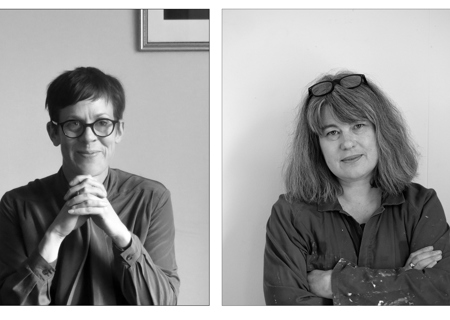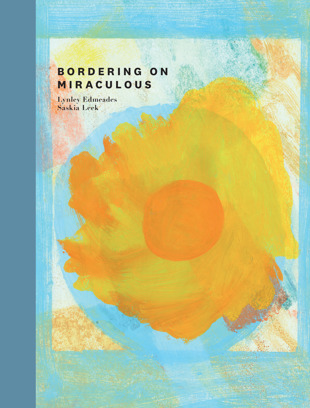Q1: These 'kōrero series' projects all begin with an approach from series editor Lloyd Jones and his suggestion of a concept on which each of you could build. What was your first reaction when he got in touch?
Saskia Leek: It was out of the blue and exciting. At first, I was paired with Bill Manhire, but we didn’t quite get the project off the ground before the first Covid lockdown and after that Bill reassessed his commitments and pulled out. I suggested Lynley to Lloyd, and we went from there. We decided to run with the concept of miracles which Bill and I had picked from a list of suggestions from Lloyd. It actually started as ‘Stories of miraculous cures’ but got abbreviated at some stage. My first impulse with the idea of miracles was to situate them within everyday domestic life.
Q2: You are both in Dunedin. Did you know each other well before you embarked on this?
Lynley Edmeades: Yes, we knew each other through some mutual friends. I had long admired Saskia’s work, and so it was an easy ‘yes’ when she got in touch about doing it.
SL: Yes, I knew Lynley a little through good friends and we were in a book club together for a while. I thought her poems would work well with the monoprints I’d started making for Bill. I sensed they could sit obliquely beside each other without directly illustrating — that they would give each other enough space.
Q3: How did you decide what your working process would be?
LE: In our early conversations, we talked a lot about concept and process. We shared the names of books and writers that we both loved, and Saskia gave me some of her earlier work to look at. It was clear to me in these early stages that we shared an interest in process, in how the doing is the interesting thing. It was this that really kept me grounded throughout the project. We would just meet to chat for the first few months. Saskia had already begun working on the drawings, and so she gave me a box of work that I took home and sat with for a while, and I would write back to these, give them to Saskia and she would respond in turn. We didn't really ‘decide’ on anything. It was very fluid.
SL: I had started making the monoprints when I was corresponding with Bill as a way of working quickly. Usually, I spend quite a long time working on individual works, painting and repainting them but I knew that that wasn't going to cut it for the volume of images required for the book. I was excited by the chance elements that the printing process threw up and the looseness. The fact that Lynley lived in Dunedin made it easy to swap pages back and forth and we got into a rhythm pretty quickly.
Q4: Did it come together relatively easily or were there some false starts?
SL: I think it came together relatively easily. The process allowed us to work without the usual kinds of pressure either of us is accustomed to putting on individual poems or paintings. We were working fast and without thinking too much.
LE: Yes, I agree with Saskia. There was a bit of push-pull in the editing process, but the actual creative part of the project was easy. Most of the difficulty lay in finalising everything, because we had a lot of material to work with and there were so many different combinations and iterations that it became hard to keep track of towards the end. But the real creative part of the process was dreamy.
Q5: Writing and painting are not normally collaborative processes. Did this partnership between you present challenges or was it perhaps energising?
SL: The fact that it wasn’t a straight writer/illustrator relationship made it easy. The idea of the series is more of a collaborative back and forth exchange. I think both of us were able to hang on to familiar aspects of our practices in terms of motifs and rhythms etc., but also embrace something new. I’ve realised that I’m not an illustrator, but I do like working alongside words.
LE: Likewise, I really enjoy working with visual prompts and with visual artists. I find it really frees me from being too in my head about an idea; having the visual somehow pulls me into the material world, even when that world is somehow concept-driven, like much of Saskia’s work.
Q6: How did it stretch you?
SL: It was a challenge for me to make a large volume of work and find ways to not be completely repetitive. It’s been very useful for me actually.
LE: In the beginning, I found myself using a kind of ekphrastic technique. But we quickly decided we didn’t want the pieces to be descriptive of the images; rather, we were more interested in how our practice and conceptual thinking overlapped. I found this much more exciting and freeing, while it took a little bit of getting used to.
Q7: What’s one new thing your learnt about each other along the way?
LE: Saskia has a really amazing collection of pottery.
SL: Lynley is great at recommending books. Also, she’s a scrabble player. I learnt this from an interview with her that I watched. I play scrabble a lot with my partner, Nick. We use the scrabble dictionary very liberally and we’ve somehow ended up with four blanks in the set we use which we’ve just left in, so we always get seven letter words. We are sort of in-house cheats. I’ve been wondering about how Lynley would feel about this loose interpretation of the rules as someone who cares so much about words.
Q8: Would you recommend a collaboration such as this to other writers and artists?
LE: Definitely. It was a pleasure to share a process with Saskia. I simply don’t understand so much of what visual artists do, and it still completely floors me how someone can make something so alive just from coloured paints on paper. It was so interesting to witness and to respond to. For me, it also took so much emotional pressure off: usually with writing, we spend so much time alone, making very solitary decisions about what to do next and why. Collaborating meant that we could forge a way ahead together and join forces to fight off the doubt when it crept it, which it always does. I’ve always been so jealous of musicians who write together, because of that shared creativity and process. This might be the closest I get to being in a band. I also had a baby not long before Saskia approached me about it, and in the wake of that (the baby) I was pretty sure I would never write anything ever again because I was so sleep deprived and disorientated. It was the perfect project for me at that particular moment, even though I wasn’t sure how I would manage it. Saskia knew that I’d just become a mother, and in her very understanding way, she suspected that the project would help keep me grounded in my artistic mind while I was changing nappies and managing my leaking boobs.
SL: Yes, I concur with Lynley about the emotional pressure. The weight of having to decide yourself whether something is worthwhile or not is sometimes crushing. Doubt can be what drives a creative process but also what stops it in its tracks. I had a tough year because my mother died, and that milestone was followed in quick succession by a breast cancer diagnosis. This was the one project that I kept on during this period, and it was just what I needed to stay creatively afloat without too much pressure.
Q9: Who came up with the title?
LE: Goddam, don’t get us started on the title! In the end, Saskia came up with the title after I’d thrown about 70 different titles at her via text message at various hours of the day and night. There were many versions of the title as it now stands, but it came really easily in the end. But for a while there it was like getting blood out of a stone. I find titles of books the most excruciating part of any book project I’ve worked on so far, so was happy to have someone else on board to throw ideas around with.
SL: We had a title, but Lloyd didn’t think it quite worked so we really thrashed around trying to find a replacement. We had plenty of motifs to work with borders, grids, suns, circularity, cups, islands, lines and miracles, but it was hard to find something encompassing but which also didn’t have too many unwanted associations and also something that didn’t ride too close to titles we’d used individually in the past. The usual problems.
Q10: Now it’s off to print are you pleased with it?
SL: Yes, I’m excited to see the final product. I think it’s going to make a nice book.
LE: Yeah, I’m really pleased with it. It’ll be a lovely artefact and an important moment for both of us as artists, I think.


